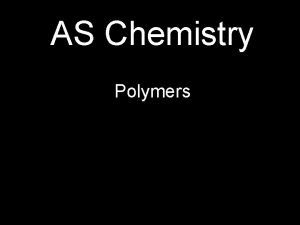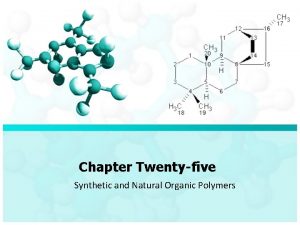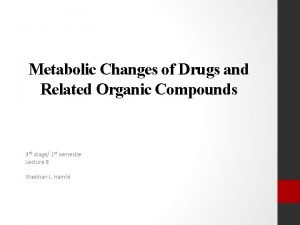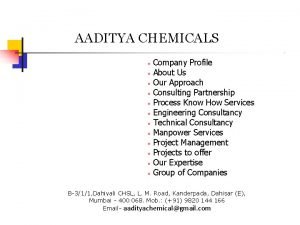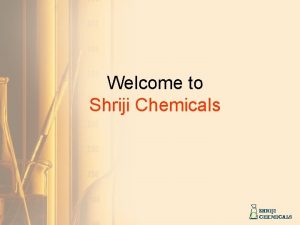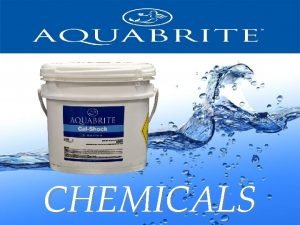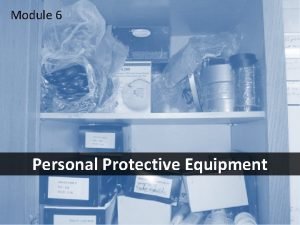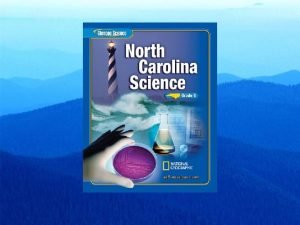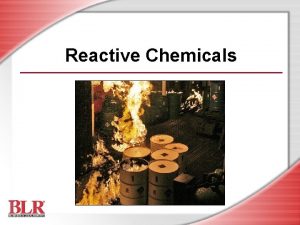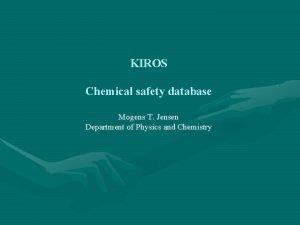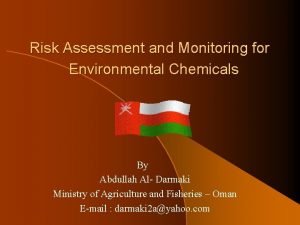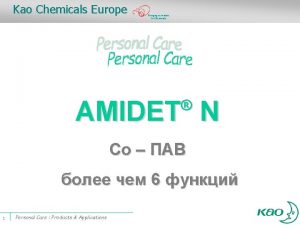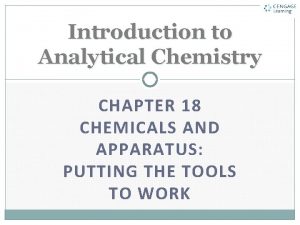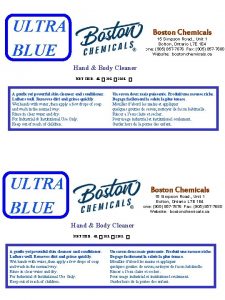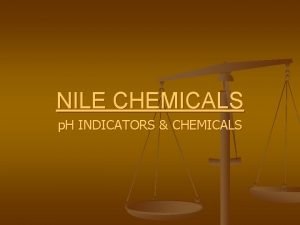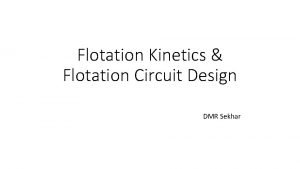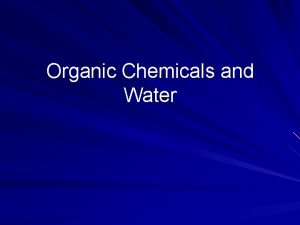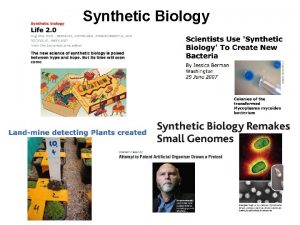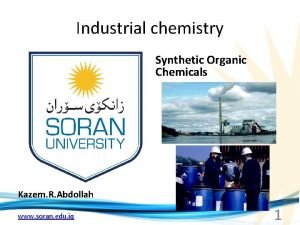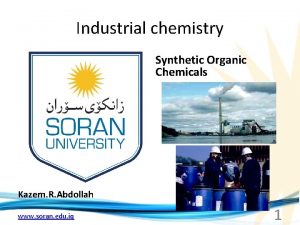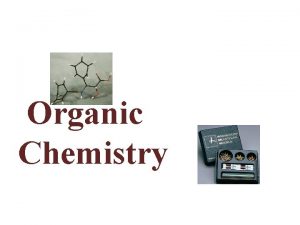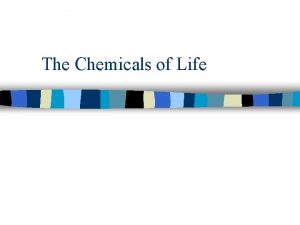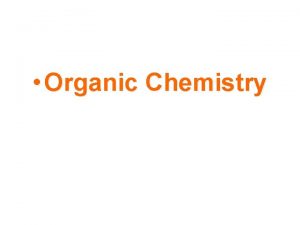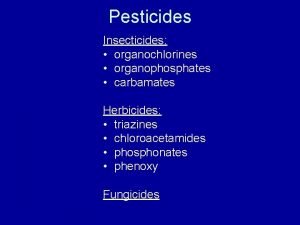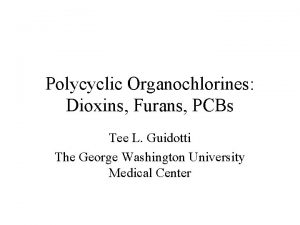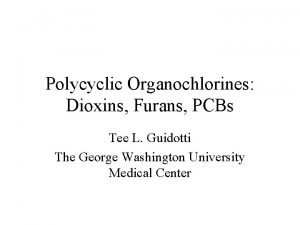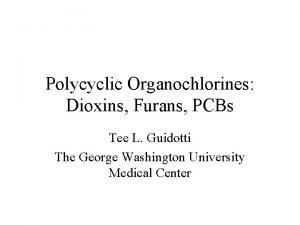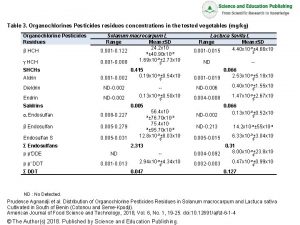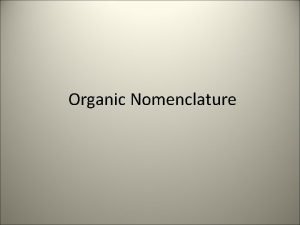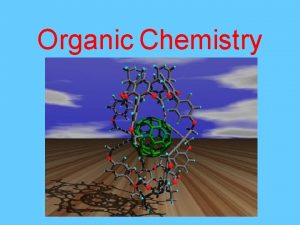Persistence of Synthetic Organic Chemicals Organochlorines persistence related




































- Slides: 36

Persistence of Synthetic Organic Chemicals

Organochlorines: persistence related to water solubility Dioxin 0. 2 µg/L DDT < 0. 1 µg/L PCB 10 µg/L Soluble in organic solvents, lipid tissues, organic sediments

Bioaccumulation in Organisms Dioxin carbon The chemical essentially dissolves into the lipid tissues

Toxaphene (670 chemicals) 400, 000 tons: 1946 to 1974 Seawater Arctic cod muscle Narwhal blubber carbon 0. 0003 ppb 14 - 46 ppb 50, 000 X 2440 - 9160 ppb ~8 MX lipid

Environmental Persistence Water DDT Solubility of < 0. 1 μg/L Organic Sediments Organic chemicals become stored in organic sediments This protects them from degradation and increases their lifetime in the environment

Lake Michigan PCBs “banned” in 1979 EPA 2004 N Concentration Organic Carbon mg Carbon /g sedimen PCBs µg PCB/Kg sediment (parts per billion) Open water PCB concentration = < 1 part per trillion

Florida Lakes and Organics

DDT dichloro-diphenyl-trichloroethane First Modern Pesticide 1948 Nobel Prize in Physiology and Medicine Insecticide developed to combat insect-borne disease Use was later expanded to include agriculture

Launch of the Environmental Movement Thinning egg shells decline in the eagle population occurred before the DDT years (bounties between 1917 and 1942) Lower hatching rates Declining Eagle population Carcinogenic primates were fed 33, 000 times more DDT than the estimated exposure 1962 human volunteers ingested 35 mg of DDT http: //faculty. unionky. edu/rbotkin/RECM_480_ISSUE_16 A_YES_BLUE. PPT#291, 22, Issue%2016: %20 Yes

Rita Island, Okeechobee Organic soils DDT levels ranging from 2, 200 to 110, 000 µg/kg (ppb) in organic soils and sediments.

Lake Apopka 30, 800 acres mean depth is 5. 4 feet 15 miles northwest of Orlando Historically characterized by clear water and a highly prized sports fishery, it served as a popular destination for boaters, swimmers, and fishermen for decades.

Pesticide Use in Agricultural Area Agriculture Pesticide use included high amounts of DDT

"Lake Apopka is a big chemical soup, " Michael Fry, a researcher from the University of California Tower Chemical Company TOC content ranges from 33 to 37% Produced dicofol, a mixture of the pesticide DDT and DDE, a by-product of DDT. Periodic spills occurred there, but a particularly large accident in 1980 caused dicofol to spread into the lake

In the 1970 s, scientists considered Lake Apopka a prime place to harvest eggs and hatchlings to study them in captivity. In 1980 and 1981, scientists counted populations of 1, 200 to 2, 000 alligators in a single night on the lake By the late 1980 s, they counted only 150 per night

Alligator Population crash was linked to poor egg viability Alligators typically produce 40 -45 eggs with a hatching rate of about 65%. In Lake Apopka, only 15 -20% hatch

DDT, DDE and Feminization of Alligators DDE, a breakdown product of DDT, is a major contaminant in Lake Apopka DDE is known to block the action of testosterone Apopka's juvenile alligators have abnormal testes and ovaries and abnormal hormone balances Estradiol Testosterone Apopka males had high levels of estradiol relative to testosterone

' Teeny Weenies ' Alligators in Florida's Lake Apopka have Smaller Penises Kyla Dunne for PBS June, 1998 http: //www. mindfully. org/Pesticide/Alligators-Apopka-PBS 2 jun 98. htm

Extra Credit 1. Bioaccumulation of synthetic organics is due to the 2. fact that the chemicals dissolve into ______ tissues 3. in organisms. 4. 2. The first modern pesticide was _________ 5. 3. The lake north of Orlando contaminated with DDT 6. 4. Animals affected by DDT contamination in the lake 7. indicated above.

Synthetic Organics, Organochlorines Assessing the Danger: Octanol

Solubility carbon Hexane carbon Acetone Dioxin organochlorine Carbon-based compounds dissolve more easily in carbonbased solvents. carbon Lipids Organic Sediments

How strong is the interaction? Bioaccumulation Persistence

An Important Organic Solvent: Octanol C 8 H 18 O c c c c Octanol is used as a reference organic solvent for neutral organic chemicals

Octanol and Water C 8 H 18 O Octanol and water are immiscible (they do not mix) Octanol is less dense than water: 0. 824 g/cm 3 octanol water C 8 H 18 O

Partitioning Between Octanol and Water Carbon/hydrogen Octanol (Carbon/Hydrogen) water C 10 H 20

Octanol-Water Partitioning Coefficient Concentration of chemical in octanol Kow = Concentration of chemical in water At equilibrium

Add 10 mg chemical 1 L Octanol 1 L Water separate octanol chemical water chemical Analyze the water phase for the chemical. Difference between initial amount and amount in water = amount in octanol The ratio between the two yields the Kow

Add 10 mg chemical 1 L Octanol 1 L Waterl separate Chemical In octanol Chemical In water 0. 01 mg L Water phase 9. 99 mg L octanol phase Kow = 9. 99 mg L 0. 01 mg L = 999

Kow of some Organochlorine Compounds DDT 8, 000 PCBs 2, 000 + Dieldrin 1, 600, 000 Mirex 3, 000 chemical in octanol chemical in water A high Kow indicates strong interaction with organic solvents and, therefore, sediments and lipid tissues

Range for Some Modern Pesticides Kow = 2 – 10, 000 m. L/g Dicamba = 4 Malathion = 2919 Chlorpyrophos = 10, 521 Far less potential for bioaccumulation Rapid Breakdown (1/2 life measured in days)

Water Filters Simple Filtration Ion Removal Carbon (most common component)

Most Common Filtration Solid Carbon Block faucet mount filters These filters, by nature, are quite small and because filter effectiveness is dependent on contact time of the water with the filter media, a larger, high-quality solid carbon block filter will be more effective at reducing contaminants at the same flow rate. A high-quality solid block activated carbon replacement filter will filter water for between 7 and 10 cents per gallon. 2 gallons of filtered water per day would cost between $50 and $100 per year

Activated Carbon Activation by heating Extremely porous with high surface area: 500 m 2/g

Activated Carbon Filtration Particle size removal > 0. 5 microns (bacteria, fungi)

Activated Carbon Absorption: spontaneous movement of primarily organic contaminants from water to carbon matrix. Pesticides, volatile organics Carbon matrix


Carbon Filter Removal 2, 4 -D 2. 4. 5 -TP (Silvex) Alachlor Atrazine Carbofuran Chlordane Endrin Heptachlor Epoxide Lindane Methoxychlor Simazine Toxaphene Benzene Carbon Tetrachloride Chlorobenzene Ethylbenzene Monochlorobenzene MTBE O-Dichlorobenzene P-Dichlorobenzene Styrene Tetrachloroethene Toluene Trichloroethene VOCs Antidepressants Steroids/Hormones Prednisone Prednisolone Progesterone Testosterone Cortisol/Hydrocortisone Antibiotics
 Specialty chemicals vs commodity chemicals
Specialty chemicals vs commodity chemicals Nylon demo
Nylon demo Synthetic organic polymers
Synthetic organic polymers Metabolic changes of drugs and related organic compounds
Metabolic changes of drugs and related organic compounds Fitness related images
Fitness related images 2 types of fitness
2 types of fitness Aaditya chemicals
Aaditya chemicals You must put all chemicals and drugs in locked cupboards
You must put all chemicals and drugs in locked cupboards Shriji chemicals
Shriji chemicals Behn meyer specialty chemicals llp
Behn meyer specialty chemicals llp Aquabrite cal-shock
Aquabrite cal-shock On july 18 2001 a train carrying hazardous chemicals
On july 18 2001 a train carrying hazardous chemicals 6 personal protective equipment
6 personal protective equipment Nova chemicals red deer office
Nova chemicals red deer office Exothermic chemicals
Exothermic chemicals Reactive chemical
Reactive chemical Workkeys applied mathematics level 5 answers
Workkeys applied mathematics level 5 answers Tasman slate sealer
Tasman slate sealer You must put all chemicals and drugs in locked cupboards
You must put all chemicals and drugs in locked cupboards Kiros kemi
Kiros kemi What are the 3 things required on a workplace label
What are the 3 things required on a workplace label Ittehad chemicals
Ittehad chemicals Oman chemicals
Oman chemicals Pti chemicals
Pti chemicals Amidet
Amidet Mangalore chemicals and fertilizers parent organizations
Mangalore chemicals and fertilizers parent organizations Dadra and nagar haveli crops
Dadra and nagar haveli crops Special purpose reagent chemicals
Special purpose reagent chemicals Boston chemicals
Boston chemicals Nile chemicals
Nile chemicals Kinetics flotation chemicals
Kinetics flotation chemicals Synthetic data
Synthetic data Synthetic theory
Synthetic theory Fiber evidence
Fiber evidence Synthetic fibe
Synthetic fibe Synthetic ruby rod
Synthetic ruby rod Dividing polynomials using synthetic division worksheet
Dividing polynomials using synthetic division worksheet

